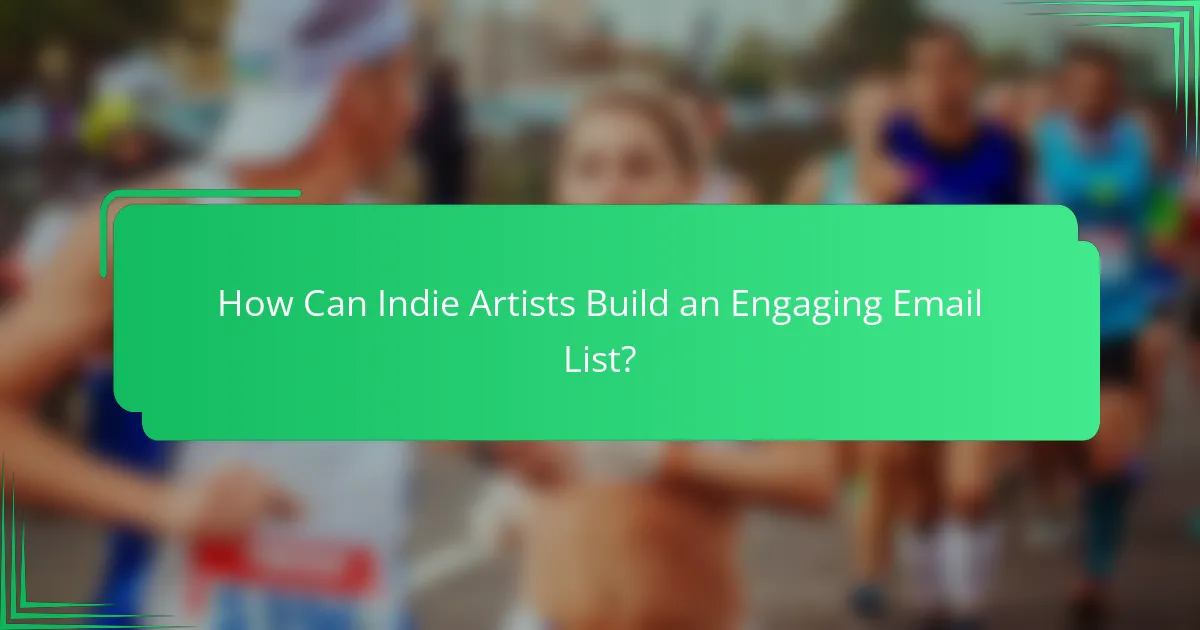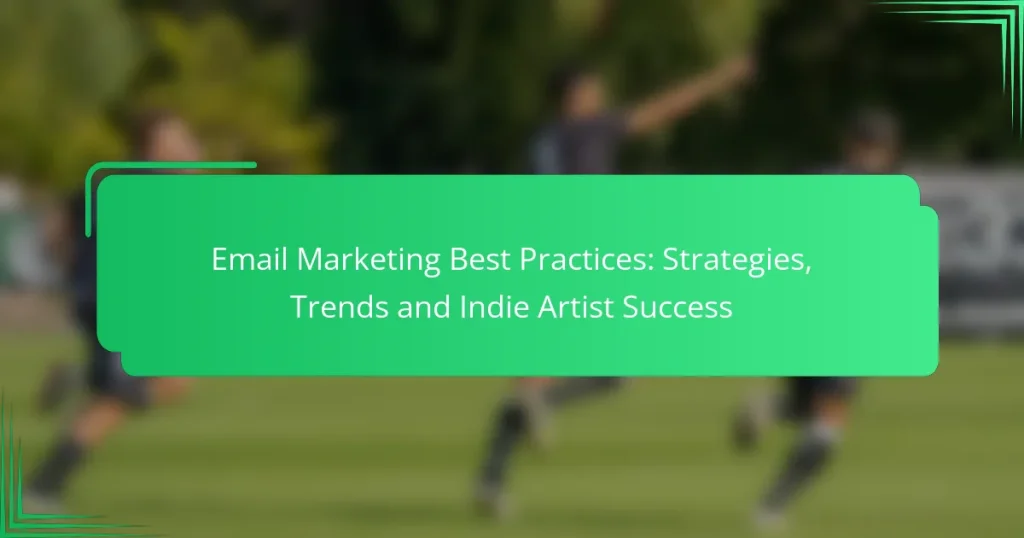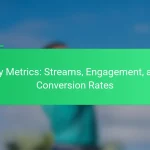Email marketing is a powerful tool for indie artists looking to cultivate a dedicated fan base through personalized and engaging communication. By implementing strategies such as effective segmentation, automation, and compelling content, artists can enhance their outreach and foster meaningful connections with their audience. Understanding key metrics like open rates and click-through rates is essential for measuring success and refining campaigns over time.

What Are the Best Email Marketing Strategies for Indie Artists?
The best email marketing strategies for indie artists focus on building a loyal fan base through targeted communication and engagement. By utilizing effective segmentation, personalization, automation, content planning, and optimizing calls-to-action, artists can enhance their outreach and drive meaningful interactions with their audience.
Segmentation Techniques
Segmentation involves dividing your email list into smaller groups based on specific criteria such as demographics, purchase history, or engagement levels. This allows indie artists to tailor their messages to different audience segments, increasing relevance and engagement.
For example, you might segment your list into fans who have attended live shows versus those who have only engaged online. This way, you can send targeted promotions for upcoming concerts to the first group while offering exclusive digital content to the latter.
Personalization Approaches
Personalization goes beyond using a recipient’s name in the subject line. It includes customizing content based on previous interactions, preferences, and behaviors. This can significantly enhance the connection between the artist and their fans.
Consider using personalized recommendations for music or merchandise based on past purchases. Tools that analyze user behavior can help create tailored content that resonates more deeply with each subscriber.
Automation Tools
Automation tools streamline your email marketing efforts by scheduling and sending emails based on user actions or predefined timelines. This ensures timely communication without requiring constant manual effort.
For instance, setting up an automated welcome series for new subscribers can introduce them to your music and upcoming events, fostering engagement right from the start. Popular platforms like Mailchimp or ConvertKit offer user-friendly automation features suitable for indie artists.
Content Planning
Effective content planning involves creating a calendar that outlines what to send and when. This helps maintain consistency and ensures that your messaging aligns with upcoming releases, events, or promotions.
Consider including a mix of content types, such as behind-the-scenes looks, exclusive previews, and fan spotlights. Planning content around key dates, like album releases or tour announcements, can help maximize engagement.
Call-to-Action Optimization
Optimizing calls-to-action (CTAs) is crucial for driving desired actions from your subscribers. A strong CTA should be clear, compelling, and relevant to the content of your email.
Use action-oriented language and make your CTAs visually distinct. For example, instead of a generic “Click Here,” use “Listen Now” or “Get Your Tickets.” Testing different CTAs can help identify which phrases and placements yield the best results.

How Can Indie Artists Build an Engaging Email List?
Indie artists can build an engaging email list by offering valuable content and incentives that resonate with their audience. This involves utilizing various strategies that encourage fans to subscribe and stay connected.
Lead Magnet Ideas
Lead magnets are incentives that entice potential subscribers to join your email list. Consider offering exclusive content such as free downloads of your latest single, behind-the-scenes videos, or early access to tickets for upcoming shows. These incentives should align with your brand and appeal to your target audience.
Other effective lead magnets include discount codes for merchandise or personalized messages for new subscribers. Aim for a mix of digital and physical rewards to cater to different preferences.
Social Media Integration
Integrating your email list with social media platforms can significantly boost your subscriber count. Promote your email sign-up link in your social media bios, posts, and stories to reach your audience where they already engage. Highlight the benefits of subscribing, such as exclusive updates and special offers.
Utilize social media ads to target specific demographics, encouraging them to join your email list. Engaging content, like polls or contests, can also incentivize followers to subscribe for more information.
Website Sign-Up Forms
Your website should feature clear and accessible sign-up forms to capture email addresses. Place these forms prominently on your homepage, blog posts, or dedicated landing pages. Keep the sign-up process simple, asking for only essential information like name and email address.
Consider using pop-up forms that appear after a visitor spends a certain amount of time on your site. This can increase conversions by targeting engaged users. Ensure compliance with regulations like GDPR if you have visitors from the EU.
In-Person Events
In-person events provide a unique opportunity to grow your email list. Set up a sign-up sheet at concerts, meet-and-greets, or festivals where fans can easily subscribe. Offering a small incentive, such as a raffle entry for concert tickets, can encourage sign-ups.
Make sure to communicate the value of joining your email list, such as receiving exclusive content or updates about future events. Collecting email addresses during these interactions can create a personal connection with your audience.

What Are the Key Metrics for Email Marketing Success?
The key metrics for email marketing success include open rates, click-through rates, conversion rates, and unsubscribe rates. These metrics help gauge the effectiveness of your campaigns and identify areas for improvement.
Open Rates
Open rates measure the percentage of recipients who open your email. A strong open rate typically ranges from 15% to 25%, depending on your industry and audience. To improve open rates, focus on crafting compelling subject lines and segmenting your email list for targeted messaging.
Consider testing different sending times and days to find when your audience is most responsive. Personalization can also enhance open rates, as emails that include the recipient’s name often perform better.
Click-Through Rates
Click-through rates (CTR) indicate the percentage of recipients who click on links within your email. A good CTR usually falls between 2% and 5%. To boost your CTR, ensure your content is engaging and includes clear calls to action.
Utilizing A/B testing for different link placements or button designs can help you determine what resonates best with your audience. Additionally, keeping your email design mobile-friendly is crucial, as many users check emails on their smartphones.
Conversion Rates
Conversion rates reflect the percentage of email recipients who complete a desired action, such as making a purchase or signing up for a newsletter. A typical conversion rate for email campaigns can range from 1% to 5%. To enhance conversions, align your email content with landing pages to create a seamless user experience.
Incorporating urgency in your messaging, such as limited-time offers, can also drive conversions. Tracking conversions through unique links or promo codes helps assess the effectiveness of your campaigns.
Unsubscribe Rates
Unsubscribe rates show the percentage of recipients who opt out of your email list after receiving a campaign. A healthy unsubscribe rate is generally below 1%. To minimize this rate, ensure your content remains relevant and valuable to your audience.
Regularly cleaning your email list by removing inactive subscribers can also help maintain engagement levels. Providing an easy way for recipients to adjust their preferences rather than unsubscribing completely can keep your audience connected.

How to Comply with Email Marketing Regulations?
Complying with email marketing regulations is essential for maintaining trust and avoiding legal issues. Key regulations like GDPR and the CAN-SPAM Act outline specific requirements for obtaining consent, managing subscriber data, and providing opt-out options.
GDPR Compliance
The General Data Protection Regulation (GDPR) applies to businesses operating in the EU or targeting EU citizens. It mandates that you obtain explicit consent from users before sending marketing emails, ensuring they understand what their data will be used for.
To comply, provide clear information about data usage and allow users to easily withdraw consent. Maintain records of consent and ensure that personal data is stored securely. Regularly review your practices to stay aligned with GDPR requirements.
CAN-SPAM Act Guidelines
The CAN-SPAM Act sets rules for commercial email in the United States, focusing on transparency and consumer rights. Key requirements include providing a clear opt-out mechanism in every email and honoring opt-out requests promptly.
Additionally, your emails must include your physical mailing address and accurate sender information. Avoid misleading subject lines and ensure that your content is relevant to the recipients. Regularly audit your email lists to remove inactive subscribers and maintain compliance.

What Are the Latest Trends in Email Marketing for 2024?
The latest trends in email marketing for 2024 focus on enhancing user engagement and personalization. Marketers are increasingly adopting interactive content, leveraging AI for tailored experiences, and ensuring mobile optimization to meet consumer expectations.
Interactive Email Content
Interactive email content allows recipients to engage directly within the email, increasing click-through rates and overall engagement. Examples include surveys, polls, and image carousels that invite users to interact without leaving their inbox.
To implement interactive elements, consider using tools that support AMP (Accelerated Mobile Pages) for email, which enables dynamic content. However, ensure that your audience’s email clients support these features, as not all do.
AI-Powered Personalization
AI-powered personalization uses data analytics to tailor email content to individual preferences, improving relevance and engagement. This can include personalized subject lines, product recommendations, and content based on past interactions.
To effectively use AI, gather data from various sources like previous purchases and browsing behavior. Be cautious about privacy regulations, such as GDPR in Europe, which require transparent data usage policies.
Mobile Optimization
With a significant portion of emails opened on mobile devices, optimizing email design for smaller screens is crucial. This includes using responsive design techniques to ensure readability and ease of navigation on smartphones and tablets.
Focus on concise subject lines and clear calls to action. Avoid large images that may slow loading times, and test your emails on multiple devices to ensure a consistent experience across platforms.


